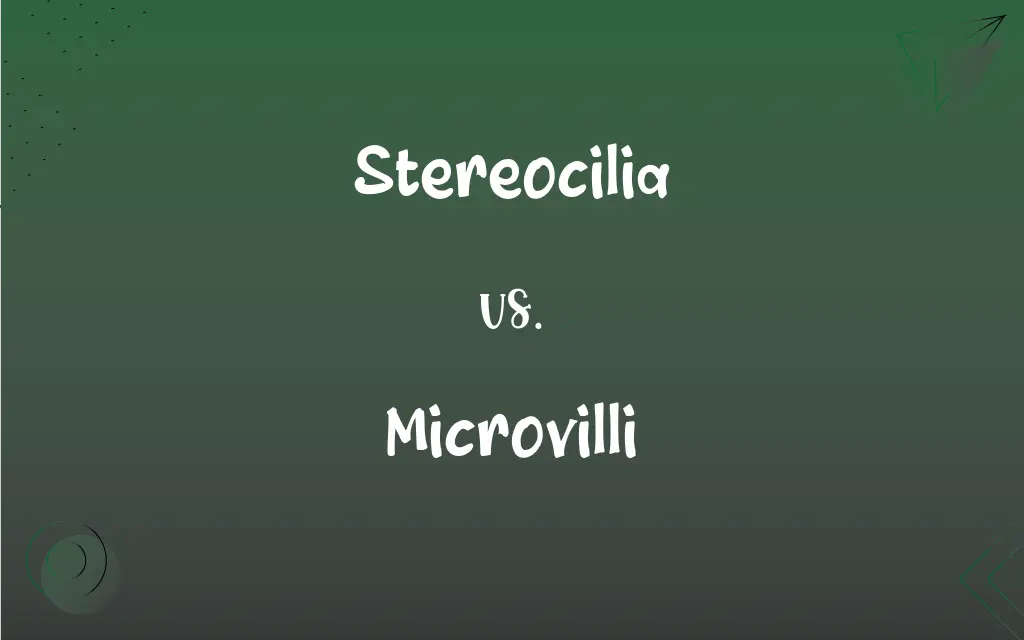Stereocilia vs. Microvilli: What's the Difference?
Edited by Aimie Carlson || By Harlon Moss || Published on March 6, 2024
Stereocilia are non-motile, hair-like projections on the surface of certain cells, crucial for hearing and balance; microvilli are small, finger-like extensions on cell surfaces, increasing absorption and secretion areas.

Key Differences
Stereocilia are elongated, rigid structures found primarily in the inner ear, particularly in the hair cells of the cochlea, where they play a critical role in the mechanotransduction of sound waves into electrical signals. In contrast, microvilli are smaller, more flexible protrusions found on the surface of many cell types, including intestinal and kidney cells, where they primarily enhance the surface area for absorption and secretion processes.
Unlike microvilli, which are widely present on epithelial cells throughout the body, stereocilia are specialized structures found in a limited number of cell types. Stereocilia are composed of actin filaments that are cross-linked to form a stiff, bundle-like structure, while microvilli have a core of actin filaments that allows for some flexibility and movement.
Stereocilia are essential for hearing and balance, as their deflection by sound waves or head movements triggers sensory hair cells to send nerve signals to the brain. Microvilli, on the other hand, do not participate in sensory reception but are crucial in enhancing the cell's surface area to facilitate efficient absorption of nutrients, ions, and other substances.
In terms of structure, stereocilia are typically longer and less numerous per cell compared to microvilli. Additionally, while stereocilia are often found in clusters called hair bundles in the sensory cells of the ear, microvilli are evenly distributed on the apical surface of epithelial cells, forming a brush border.
Functionally, stereocilia's role in the sensory perception of sound and balance is distinct from microvilli's role in absorption and secretion. This functional difference is reflected in their unique cellular locations, structure, and molecular composition, highlighting the specialized nature of stereocilia compared to the more generalized function of microvilli.
ADVERTISEMENT
Comparison Chart
Location
Inner ear cells
Epithelial cells throughout the body
Structure
Long, rigid, actin filament bundles
Short, flexible, actin filament core
Function
Sound and balance perception
Absorption and secretion enhancement
Presence
Limited to specific cell types
Widespread on various cell types
Cellular Role
Sensory transduction
Surface area enlargement
ADVERTISEMENT
Stereocilia and Microvilli Definitions
Stereocilia
Stereocilia are actin-based structures on auditory cells, aiding in sound transduction.
The stereocilia bend in response to sound vibrations, initiating neural signals.
Microvilli
Microvilli are small protrusions on epithelial cells, aiding in secretion and absorption.
The dense microvilli on kidney cells facilitate efficient waste secretion.
Stereocilia
Stereocilia are specialized, hair-like protrusions found in the cochlea of the inner ear.
The arrangement of stereocilia in the ear is crucial for detecting different sound frequencies.
Microvilli
Microvilli are tiny, finger-like extensions on cell surfaces, increasing absorption area.
The microvilli in the intestine greatly expand the surface for nutrient absorption.
Stereocilia
Stereocilia are non-motile, rigid projections on sensory hair cells, essential for hearing.
Damage to the stereocilia in the inner ear can lead to hearing loss.
Microvilli
Microvilli are cellular structures with a core of actin filaments, enhancing cell surface.
Cells with numerous microvilli can interact more effectively with their environment.
Stereocilia
Stereocilia are elongated, stiff structures on certain cells, involved in mechanosensation.
The height and stiffness of stereocilia are critical for their sensory function.
Microvilli
Microvilli form the brush border of epithelial cells, crucial for efficient substance exchange.
The microvilli in the gut epithelium help in the digestion and absorption of food.
Stereocilia
Stereocilia are unique cellular appendages, playing a key role in the sense of balance.
Stereocilia movement in response to head tilts helps maintain equilibrium.
Microvilli
Microvilli are involved in cellular functions like nutrient uptake and enzyme secretion.
Enzymes secreted at the microvilli aid in breaking down complex food molecules.
Stereocilia
Plural of stereocilium
Microvilli
Any of the minute hairlike structures projecting from the surface of certain cells, such as those lining the small intestine.
Microvilli
Plural of microvillus
FAQs
How do stereocilia function in hearing?
Stereocilia convert mechanical sound waves into electrical signals for auditory perception.
What are stereocilia?
Stereocilia are stiff, hair-like structures on certain sensory cells, essential for hearing and balance.
What is the structure of stereocilia?
Stereocilia are composed of tightly packed actin filaments, forming a rigid, elongated structure.
Can stereocilia regenerate if damaged?
Unlike some animals, human stereocilia cannot regenerate, and damage can lead to permanent hearing loss.
Where are microvilli most commonly found?
Microvilli are commonly found in the intestines and kidneys, where absorption and secretion occur.
How do microvilli aid in absorption?
Microvilli increase the cell's surface area, enhancing the efficiency of nutrient absorption.
Where are stereocilia found?
Stereocilia are found in the inner ear, particularly in the cochlea and vestibular system.
Are microvilli present in all cell types?
No, microvilli are primarily found on epithelial cells in specific organs like the gut and kidneys.
Are stereocilia and microvilli motile?
Stereocilia are non-motile, while microvilli also do not exhibit active movement.
Do microvilli contain organelles?
No, microvilli do not contain organelles but have a cytoplasmic extension with actin filaments.
What are microvilli?
Microvilli are small, finger-like projections on the surface of epithelial cells, increasing surface area.
Can stereocilia be found outside the ear?
Stereocilia are predominantly found in the inner ear and are not present in other body parts.
Are stereocilia and microvilli genetically determined?
Yes, the development and structure of both stereocilia and microvilli are genetically determined.
Can the number of microvilli vary between cells?
Yes, the number and density of microvilli can vary based on the cell type and its function.
Do stereocilia and microvilli have similar functions?
No, stereocilia are involved in sensory perception, while microvilli enhance absorption and secretion.
Are microvilli visible under a light microscope?
Microvilli are too small to be seen under a light microscope and require an electron microscope.
How do stereocilia contribute to balance?
Stereocilia in the vestibular system respond to head movements, aiding in maintaining balance.
What happens if microvilli are damaged?
Damage to microvilli can impair absorption, leading to malabsorption syndromes or nutrient deficiencies.
Are there medical conditions related to stereocilia dysfunction?
Yes, conditions like sensorineural hearing loss and balance disorders can arise from stereocilia dysfunction.
What is the structural composition of microvilli?
Microvilli have a core of actin filaments, providing some flexibility and support.
About Author
Written by
Harlon MossHarlon is a seasoned quality moderator and accomplished content writer for Difference Wiki. An alumnus of the prestigious University of California, he earned his degree in Computer Science. Leveraging his academic background, Harlon brings a meticulous and informed perspective to his work, ensuring content accuracy and excellence.
Edited by
Aimie CarlsonAimie Carlson, holding a master's degree in English literature, is a fervent English language enthusiast. She lends her writing talents to Difference Wiki, a prominent website that specializes in comparisons, offering readers insightful analyses that both captivate and inform.































































